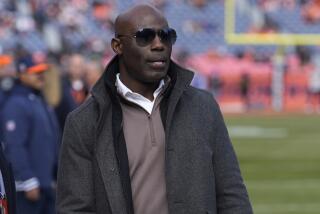A ‘Heck of a Ride’ at TWA
- Share via
They began serving passengers as college-educated TWA “hostesses,” wearing hats and white gloves. They catered to movie stars and foreign dignitaries seated next to travelers in their Sunday best.
Decades later, the glamour is gone. Their airline is about to be merged out of existence. But they still are flying, five flight attendants who have seen commercial aviation change radically along with the country’s attitudes toward women and the workplace.
Attendants at other carriers may have more seniority individually, but no other cabin crew in the nation is like the “golden girls, “ as they call themselves. Together they have more than 200 years of experience. They’ve been on the same flight schedule for three decades.
TWA Flight 894 recently left Los Angeles International Airport for Washington, D.C., with all five aboard. Some of them first flew when Elvis Presley was hitting the charts and Dwight D. Eisenhower was president. Now they are the airline’s most senior flight attendants, working with pilots who are children of pilots they once flew with.
Beverly Sanford was one of the youngest among the group, with 37 years under her pin. She was working first class with Dolores “Dodo” Narz, the No. 1 attendant at TWA, who was in her fifth decade with the airline. “We’ve been like a sorority in the air, but that’s sadly coming to an end,” Sanford said.
It was one of their final flights as a group. Today, they begin working separate shifts now that their direct Los Angeles-to-Washington route has been eliminated.
Trans World Airlines was acquired in April by American Airlines, which plans to take the TWA name off aircraft over the next year and give flight attendants new uniforms.
It marks the final chapter for a once-stellar airline that had many notable firsts: the first to serve freshly brewed coffee in-flight (1957), the first in-flight movie (1961) and the first all-jet fleet (1967). It also once dabbled with paper dresses for flight attendants until the crews complained about how they tore and didn’t keep them warm in the winter.
The golden girls--all based in Los Angeles--had seen and lived through most of it, from TWA’s glory days to an airline that struggled to keep financially afloat. In an ignominious send-off, Forbes magazine earlier this year dubbed TWA the worst airline for bumping passengers on overbooked flights.
“It does bring tears to my eyes to think of what an airline it was,” said Sanford, who began flying as jet planes began to enter service. “TWA has had its day.”
The same cannot be said about the senior attendants, who plan to keep flying two or three times a week.
On the flight from Los Angeles to Washington, Cathy Gordon, a 36-year veteran at TWA, boasted to an incredulous passenger that not only was her uniform older than he but that she was the youngest attendant in the cabin.
Gordon, 56, a native of Mattoon, Ill., is considered a baby among the crew that includes Narz, who is completing her 48th year with TWA, according to airline officials. Narz, a legend in the industry, doesn’t much care for the No. 1 title and refuses to divulge any information or give any hints that could help someone trace her age. TWA sources put her age at 72.
“I really don’t like titles,” she said before kneeling to grab a can of apple juice that had fallen under a seat.
“See the glamour?” Narz said as she felt a tear in her pantyhose.
Narz estimates she has worn out about 15,000 pairs of hose. At an average of three pairs per flight, which is what she said she wears out, and two flights per week, that would place the start of Narz’s career at a time when the propeller-driven Lockheed Constellation filled the skies. Narz said that her first flight was in a Martin 202, a 36-passenger twin-propeller airplane built in the 1950s.
Charmed by Narz’s sharp, barroom ripostes and cackling laugh, actress Joan Crawford once volunteered to help her serve dinner, perhaps the first time that a movie icon worked the aisles.
And once, Narz consoled Elizabeth Taylor as the actress was flying home after a headline-grabbing breakup with Richard Burton. And there was the time when she had a fling with Cary Grant. “He was a private person, a real gentleman,” Narz said, declining to provide further details.
Youthful indiscretions aside, Narz, who has been happily married for more than 30 years to Jack Narz, one of television’s original game show hosts, said flying was a far different experience back then.
Passengers wore their best suits and dresses, even if it meant sitting on the plane for a cross-country trip that took as long as 10 hours. The “hostesses” were expected to fit a Barbie-like image: blond with blue eyes, wearing a size 6 dress with stockings, hat and white gloves. Long hair was forbidden--short “Kookie” cuts, as they were called, were mandatory. Everyone had to use Revlon’s Persian Melon lipstick.
Narz was the epitome of the glamorous TWA hostess. When the airline wanted an image change, she obliged. In the mid-1960s, the airline renamed them “stewardesses” and ordered them to adopt “the girl-next-door” look. That meant blonds had to dye their hair black.
Mary Jo Knipe, a 39-year veteran who raised four children in between flights, kept a 1960s issue of Cosmopolitan featuring black-and-white photographs of TWA stewardesses going through training. The headline read: “What They Teach You (About Men) in Airline School.”
The half-dozen photographs show young women who appear almost identical, wearing TWA’s signature short haircut accented by a slight curl around the ears, long false eyelashes and narrow, meticulously plucked eyebrows.
“Woman didn’t have many options,” said Knipe, who has lived in Torrance since she moved west from her hometown of Columbus, Ohio, in 1963. “We were expected to be either housewives or secretaries, and the opportunity to become an airline hostess seemed so exciting.”
Still, career advancement for women was severely restricted. Women were not allowed to be pursers--the cabin crew boss--until the early 1970s.
Knipe, 58, was one of the few hostesses who not only married but raised children at a time when two-income households were an oddity. TWA’s attitude toward marriage then resembled current military policy toward gay personnel, she said: Don’t ask, don’t tell.
Becoming a hostess was rigorous. A college degree was required when most women had only a high school education. They were expected to be young--perhaps in their early 20s--and single. They signed contracts agreeing to retire if they got married, had children or when they reached the age of 32. Airlines dropped many of the requirements 30 years ago.
Three of the women are single. “I’ve been engaged a couple of times, but never married,” said Gordon, who lives in Playa del Rey. “I thought I was too young and then all of a sudden I was too old.”
There was a certain cachet in becoming an airline hostess, said June O’Mahoney, who is single and has been with TWA 42 years. She was working the coach class on the recent flight, along with Gordon and Knipe.
In 1959, 20-year-old O’Mahoney, who had just immigrated to the U.S. from London, applied to be a TWA hostess, not knowing she would have to compete against 112 other candidates. After surviving three days of interviews, O’Mahoney was sent to TWA’s famed airline school in Kansas City, Mo., where trainees stayed at a posh Spanish Mediterranean-style hacienda that seemed more like a resort than a school.
“We were starry-eyed then. I was in awe of everything I saw,” said O’Mahoney, 62, who moved to Torrance in 1960. She rattled off her extensive list of celebrity encounters: Bob Hope, Tatum O’Neal, Julie Andrews. And then there was Gregory Peck. “He was charming, absolutely charming.”
Flying TWA was an event then, a luxury for the few who got to sit in leather seats next to windows with curtains and be served meals on imported china with Tiffany silverware.
Nowadays, passengers are more likely to wear bluejeans and flip-flops than silk ties and wingtips.
“It’s just not the same anymore,” Sanford said as she folded paper napkins much like the way she used to fold linens that were once a standard. “We used to have trainers from Europe teach us about dinner service.”
Sanford, a native of Belleville, N.J., who moved to Los Angeles in 1965, said she dreamed about flying around the world since she was a young child, and the best way to do that was to work for an airline. TWA had the best routes, she said.
“When you were hired, you felt special.”
TWA also had one of the more illustrious histories in the industry. Charles Lindbergh laid out its first transcontinental route. Eccentric billionaire Howard Hughes acquired control of the airline in 1939 and kept it for 25 years, drawing a host of celebrities in the process.
Takeover specialist Carl Icahn took control in 1985. In 1988 he took the company private, extracting a $469-million profit for himself and leaving the company with more than half a billion dollars in debt. Eventually, Icahn sold off TWA’s most lucrative routes, including New York to London, before relinquishing control in 1993.
The airline never recovered, posting losses for the last decade and filing for its third Chapter 11 bankruptcy last year before it was acquired by American Airlines.
As TWA’s standing in the industry diminished, passengers’ expectations also changed dramatically.
“It’s gotten to be like a Greyhound bus,” Narz said. Passengers are less respectful and courteous, and the ladies don’t get to fly to exotic places like they used to. But that hasn’t diminished their affection for their jobs.
“I love to fly. It’s in my bone and blood,” Narz said. “I don’t need the money. I give [husband] Jack fits because it costs me more in taxes to work than to stay home, but I still get a kick out of it.”
Narz grew up in Canonsburg, Pa., a small town in the hills just outside Pittsburgh, where she served drinks to coal miners in her father’s bar. She earned a master’s degree in education from the University of Pittsburgh and taught high school English before she decided she wanted to “see the world” and applied to be a hostess.
“I’m a gypsy,” Narz said. “I love going places. I get real antsy staying home.”
The five women have been flying so long that more than just a few pilots are children of pilots that they flew with in earlier years. On the return trip from Washington to Los Angeles on Flight 895, Capt. Tom Solomon came out of the cockpit to talk with Narz, who first flew with his father, J.S. Solomon, in the 1960s.
“I remember when he introduced me to Dodo,” Solomon said. “I was just a kid then.”
Not one of the attendants has been involved in a serious mishap, although there have been some close calls.
Lightning hit Narz’s airplane once. O’Mahoney recalled surviving a flight in which an engine exploded on a Boeing 747.
“The airplane was losing altitude and all I could do was stay in my seat and smile at the passengers who were all wondering what was going on,” she said. “That was difficult.”
Most of the problems nowadays, the women said, come from passengers who drink too much. After so many years of flying, they’ve learned to spot a potential problem, which means gradually watering the drinks in first class and paying particular attention.
Narz has plenty of experience to draw on: “I started working when I was 5 and learned how to deal with drunks very quickly.”
All five said they are looking forward to working for American Airlines.
“American Airlines has some great routes. I’m looking forward to new adventures. I’m gonna give it a whirl,” Narz said, vowing to keep flying until “I get grounded.”
Still, Narz and others became a little teary-eyed thinking about the glory days of TWA.
“We were always a quality airline,” Gordon said as she lowered her reading glasses after scanning through the flight’s inventory. “It’s been one heck of a ride.”
*
MORE INSIDE
Power shift: This Labor Day, firms have edge in job market. C1
Worker ties: Unions, churches join in on ‘Labor in the Pulpit.’ B3
More to Read
Sign up for The Wild
We’ll help you find the best places to hike, bike and run, as well as the perfect silent spots for meditation and yoga.
You may occasionally receive promotional content from the Los Angeles Times.






